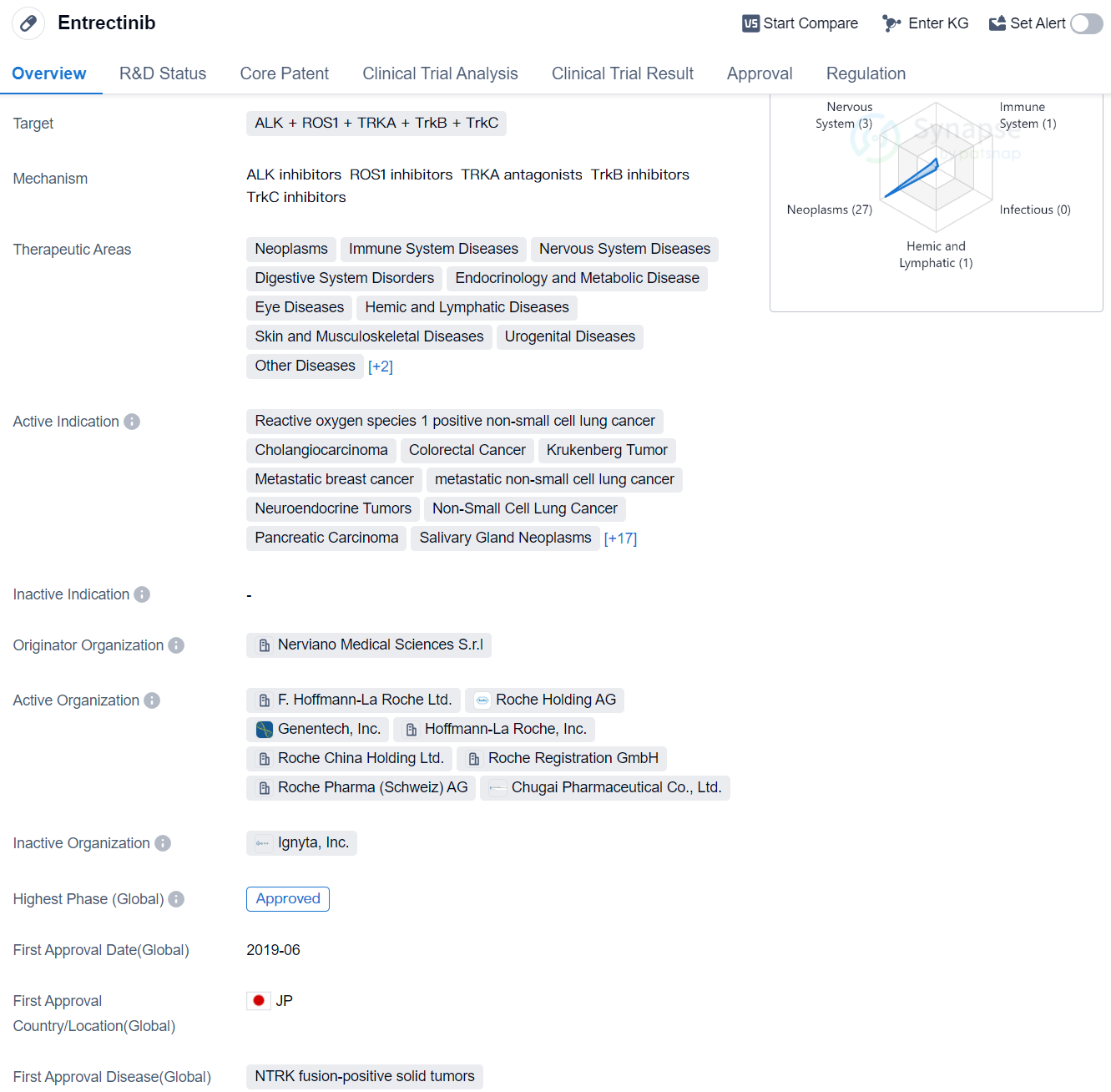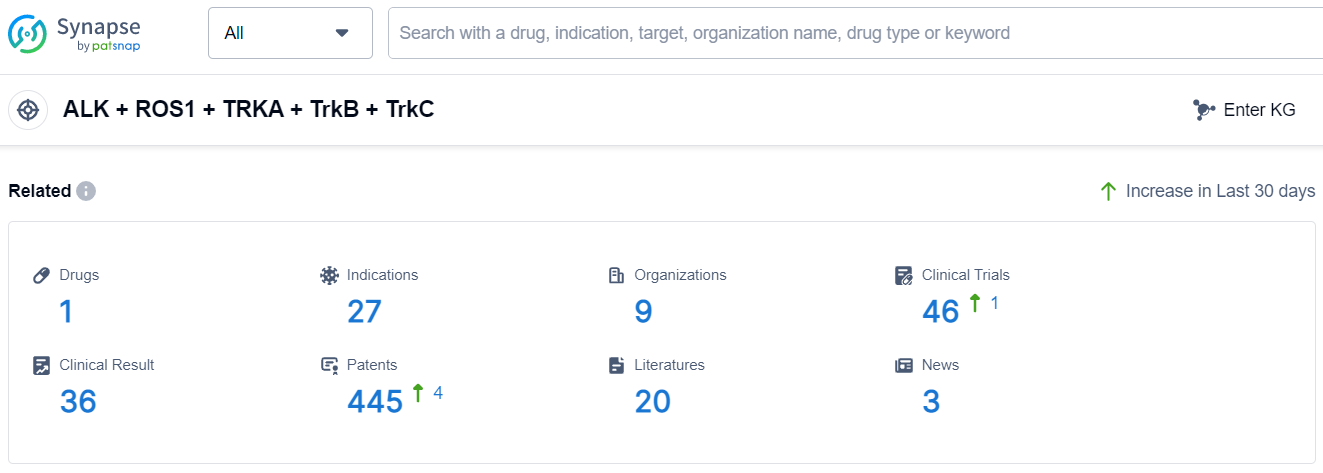Unleashing the Power of Entrectinib: A Comprehensive Review on R&D Breakthroughs
Entrectinib's R&D Progress
Entrectinib is a small molecule drug that targets multiple proteins including ALK, ROS1, TRKA, TrkB, and TrkC. It has shown potential therapeutic benefits in various therapeutic areas such as neoplasms, immune system diseases, nervous system diseases, digestive system disorders, endocrinology and metabolic disease, eye diseases, hemic and lymphatic diseases, skin and musculoskeletal diseases, urogenital diseases, other diseases, mouth and tooth diseases, and respiratory diseases.
The drug has been indicated for the treatment of several types of cancers including reactive oxygen species 1 positive non-small cell lung cancer, cholangiocarcinoma, colorectal cancer, Krukenberg tumor, metastatic breast cancer, metastatic non-small cell lung cancer, neuroendocrine tumors, non-small cell lung cancer, pancreatic carcinoma, salivary gland neoplasms, sarcoma, solid tumors, thyroid cancer, NTRK fusion-positive solid tumors, brain cancer, uveal melanoma, brain metastases, central nervous system neoplasms, anaplastic large-cell lymphoma, breast cancer, melanoma, ovarian cancer, pancreatic cancer, papillary thyroid cancer, renal cell carcinoma, neuroblastoma, and acute myeloid leukemia.
The drug was developed by Nerviano Medical Sciences S.r.l and has received approvals in various countries. Entrectinib has reached the highest phase of development which is approved globally . The drug received its first approval in Japan in June 2019.
Entrectinib has been regulated under various designations including priority review, accelerated approval, orphan drug, and breakthrough therapy. These designations highlight the potential significance of the drug in addressing unmet medical needs and expediting its development and approval process.
👇Please click on the image below to directly access the latest data (R&D Status | Core Patent | Clinical Trial | Approval status in Global countries) of this drug.
Mechanism of Action for Entrectinib: ALK inhibitor and ROS1 inhibitor and TRKA antagonist and TrkB inhibitor and TrkC inhibitor
ALK inhibitors are a type of medication that specifically target and inhibit the activity of anaplastic lymphoma kinase (ALK), a protein that is involved in cell growth and division. These inhibitors are commonly used in the treatment of certain types of cancer, such as non-small cell lung cancer, that have genetic alterations in the ALK gene. By blocking the activity of ALK, these inhibitors help to slow down or stop the growth of cancer cells.
ROS1 inhibitors, on the other hand, target and inhibit the activity of ROS1, a receptor tyrosine kinase that is also involved in cell growth and division. Similar to ALK inhibitors, ROS1 inhibitors are used in the treatment of specific types of cancer, such as non-small cell lung cancer, that have genetic alterations in the ROS1 gene. By blocking ROS1 activity, these inhibitors can effectively suppress the growth and spread of cancer cells.
TRKA antagonists are drugs that work by blocking the activity of the tropomyosin receptor kinase A (TRKA) protein. TRKA is a receptor tyrosine kinase that plays a role in nerve growth and development. By antagonizing TRKA, these drugs can modulate the signaling pathways involved in nerve growth, potentially offering therapeutic benefits in certain neurological disorders.
TrkB inhibitors, on the other hand, target and inhibit the activity of the tropomyosin receptor kinase B (TrkB) protein. TrkB is another receptor tyrosine kinase that is involved in neuronal development and function. Inhibiting TrkB activity can have implications in the treatment of various neurological conditions, such as neurodegenerative diseases and mood disorders.
TrkC inhibitors, similar to TrkB inhibitors, target and inhibit the activity of the tropomyosin receptor kinase C (TrkC) protein. TrkC is a receptor tyrosine kinase that is primarily involved in the development and maintenance of the nervous system. Inhibiting TrkC activity can potentially have therapeutic applications in the treatment of neurological disorders and conditions related to nerve regeneration.
In summary, the text refers to different types of drugs or drug targets that are relevant in the field of biomedicine. ALK inhibitors and ROS1 inhibitors are used in cancer treatment, while TRKA antagonists, TrkB inhibitors, and TrkC inhibitors have implications in the treatment of various neurological disorders.
Drug Target R&D Trends for Entrectinib
The analysis of the target ALK + ROS1 + TRKA + TrkB + TrkC reveals a competitive landscape with Roche Holding AG leading in terms of the highest phase of development and drug count. The approved drugs under this target have indications ranging from various types of cancer to solid tumors. The presence of small molecule drugs indicates intense competition in the development of innovative therapies. The development of drugs targeting ALK + ROS1 + TRKA + TrkB + TrkC is progressing globally, with countries like China, the United States, and the European Union actively involved. The future development of this target holds potential for advancements in the treatment of various cancers and solid tumors.
According to Patsnap Synapse, as of 8 Sep 2023, there are a total of 1 ALK + ROS1 + TRKA + TrkB + TrkC drugs worldwide, from 9 organizations, covering 27 indications, and conducting 46 clinical trials.
Please click on the picture link below for free registration or log in directly if you have a freemium account, you can browse the latest research progress on drugs, indications, organizations, clinical trials, clinical results, and drug patents related to this target
Conclusion
In summary, entrectinib is a small molecule drug that targets multiple proteins and has shown promise in treating various types of cancers and other diseases. Its approval in multiple countries and the regulatory designations it has received further emphasize its potential therapeutic benefits. The drug's development by Nerviano Medical Sciences S.r.l showcases the expertise and innovation within the pharmaceutical industry in the field of biomedicine.






